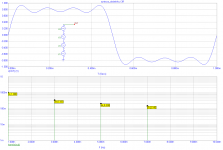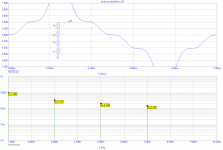What do you define as "artificial" records? Is it the recording technique or the sources themselves?
Welcome to the discussion Pano!
It is what I meant on the previous page:
I mentioned phase coherence issue on arrays with a real sub. Something tells me that the body participates as well, not only ears.
However, it may be no issue if to play the majority of modern records. They not only have multi-dimensional mix, but often multi-environmental, when different instruments were recorded in different rooms, or even different reverberations applied. When the record is artificial it will always sound artificially, no matter which speakers to use.
The discussion was about phase coherence: where it is required, or not. Some pelple believe that it is enough if the reproduction contain only needed set of harmonics, waveshape does not matter, because ears do not recognize it. I know it is wrong, wave shape matters. If we want to fool imagination as if the sounds are real we have to preserve wave shape. However, if we synthesize something artificial it may be not necessary.
Last edited:
Glad you said that and not me. Whenever I say that really great systems reveal great stuff in what many consider "bad" recordings I get slammed for it.
You know, "Rubbish! Better systems just make bad recordings sound worse." Or words to that effect.
While I wouldn't go so far as to say that all recordings can be revealed to contain hidden sonic gems, many do. Part of my fascination with really great systems is their ability to let you hear past the recording flaws and into the music. Not a lot of folks agree with that, it seems.
+2. I have noticed the same thing many times over the years. After improving components, I go back to some recordings I thought were not that good, and wow. Sometimes it is the equipment that gives a particular recording a bad rap.
Good observation.
Last edited:
Right, I read that in your post, but was confused by the term "artificial." I do tend to prefer minimal mic and mixing techniques as they often sound more real to me, but my point was that in the hands of a skilled engineer, it can be quite surprising how realistic totally fake set-ups can sound. Like good C.G. in movies, you don't know it's fake. Or even if you do, it can seem amazingly real.The discussion was about phase coherence: where it is required, or not.
Now that said, my wife just bought me an old London Records Phase 4 Stereo LP from 1962 that was recorded on a 20 channel mixer and 4 track master tape. It's spectacular, but not very real. Doesn't matter tho, it's crazy fun.
Earl has published a great deal of data on applications of the metric. What new thing are you looking for?
There is plenty of data floating around similar to Earl's for a long time. His is more up to date. I want a range of new test instruments or hard/firmware which does more than harmonic and thd and Im et al. With features which would integrate Earl and other info into test and measurment equipment in a convenient to use and plots which have the added weighting and other such parameters besides just/only electrical phenominon. [Like weighting which is standard feature in SPL measurements.]
In other words... measurements which correlate a little better to hearing etal. Even if they are an optional feature to the basic instrument.
Thats all I want. -- Signed - test equipment Junky. RNM
Precisely.Part of my fascination with really great systems is their ability to let you hear past the recording flaws and into the music. Not a lot of folks agree with that, it seems.
I've made a point of hunting out extremes in recording quality, and the poorest possible transfers, just to test out how far you can take this. And I'm pleased to say that I have yet to be proven wrong, even when I, in a weak moment say, No way ... I can't rescue that recording!!, and then further down the track realise that I had been listening to reproduction that wasn't as good as it could be.Yes - on this I concur with you Pano and disagree with Frank. His claim that 'all recordings do' is actually only 'all recordings Frank has heard'.
And this depends on where the natural strengths of a system are. My current setup takes a bit of fine jigging to handle really dense recordings, my latest "hurdle" is a 2007 album by the Foo Fighters, from the library -- you don't think I would buy this sort of stuff!!
Frank
It appears that the compressed sound from MP3 is on the order of yielding up a dynamic range of only 2 to 1. Anyone know fer sure?
no reason for a limit I know of - dynamic range compression should be orthogonal to psychoacoustic lossy data compression
I once tried a direct encode/decode experiment which showed single sine had ~ -80d spurs&distortion http://www.diyaudio.com/forums/anal...-3v-1khz-sine-wave-generator.html#post2786744
MP3 may often be used to distribute pop music - which is mastered with heavy "Loudness War" dynamic range compression - but that is just correlation - not causation
I have certainly used similar Ogg Vorbis and WMA data compression formats on decent jazz CDs without obvious loss of music dynamic range
Last edited:
There is plenty of data floating around similar to Earl's for a long time. His is more up to date. I want a range of new test instruments or hard/firmware which does more than harmonic and thd and Im et al. With features which would integrate Earl and other info into test and measurment equipment in a convenient to use and plots which have the added weighting and other such parameters besides just/only electrical phenominon. [Like weighting which is standard feature in SPL measurements.]
In other words... measurements which correlate a little better to hearing etal. Even if they are an optional feature to the basic instrument.
Thats all I want. -- Signed - test equipment Junky. RNM
Ian Hegglun has an interesting article in Linear Audio Vol 4 about weighing regular THD measurements giving results that appear to correlate quite well with listening tests.
For instance, it has always been difficult to express the measurend xover distortion in numbers correlating with listening tests because their effect depends so much on dynamic issues, signal levels etc.
With Ian's weighing principle the correlations seems much better.
jan
I would think that in theory it ought to be possible since the waveform gives you the in-out function (assuming sine wave input) and the FFT preserves all the information in the waveform.gpapag said:I would like to ask if there is a way to derive the Gedlee Metric of the DUT from the FFT (amplitude and phase of the harmonics) of the output (OK at some different signal levels too)?
Something that Ben Duncan was suggesting in HiFi News, oohh, at a quick guess, in the region of over 20 years ago ...Ian Hegglun has an interesting article in Linear Audio Vol 4 about weighing regular THD measurements giving results that appear to correlate quite well with listening tests.
For instance, it has always been difficult to express the measurend xover distortion in numbers correlating with listening tests because their effect depends so much on dynamic issues, signal levels etc.
With Ian's weighing principle the correlations seems much better.
jan
Frank
Thank you for putting it here at this time. It certainly needs to be done asap. Its been way, way too long in coming. The data on many FFT can be found in a list of the actual measured values that are plotted. If this data was in a spread sheet, it would be just as easy to add the weighting and replot the data. Then we will have something better to correlate and make refinements to it and we are on our way to more meaningful tests/measurements.
Any takers to work on this project?? maybe Audio Precision? -RNM
Mr. Geddes has been disappointed on the "no response" from the part of the audio professional sector.
I can’t say what their explanations are.
From my amateurish part, I would really like to be able to test his metric.
Alas, I don’t know how to handle the formula for Gm in practice.
This formula calls for the analytical form of the DUT’s transfer characteristic. This is not good news for me, or at least I can not see how to handle it.
I can vary the signal level and have the DUT output/input recorded through a soundcard. Then transform these two signals into data pairs and have them imported on a spreadsheet. Then what?
I can also have the output & input of the DUT entered into a spreadsheet, the FFT of which (the amplitude and phase of the harmonics) are calculated and displayed and where manipulation (weighting) can be applied onto them. Then what?
George
Last edited:
Well at least they are honest about it.
"Similarly, the graphs do not prove that the rejection
measured in the lab has a perceptible (ie audible) effect
when the cables are used in a Hi-Fi or Home Cinema System."
And to their credit they did good testing. But if you need power cords with RF rejection, wouldn't simple shielded mains cable be easier?
"Similarly, the graphs do not prove that the rejection
measured in the lab has a perceptible (ie audible) effect
when the cables are used in a Hi-Fi or Home Cinema System."
And to their credit they did good testing. But if you need power cords with RF rejection, wouldn't simple shielded mains cable be easier?
I would like to ask if there is a way to derive the Gedlee Metric of the DUT from the FFT (amplitude and phase of the harmonics) of the output (OK at some different signal levels too)?
http://www.gedlee.com/downloads/THD_.pdf
George
George, I have asked several times without answer, "Does the metric hold when all distortions are -100dB or so?" Earl has implied several times that it is relatively easy these days to find electronics that are "transparent", and my impression is he does not believe in most (any?) of the extreme beliefs.
I once tried a direct encode/decode experiment which showed single sine had ~ -80d spurs&distortion http://www.diyaudio.com/forums/anal...-3v-1khz-sine-wave-generator.html#post2786744
I did a different experiment, encode a 1 min. 60Hz sine wave and then add one cycle over the whole minute. The output was perfect even at 128k encoding.
- Status
- Not open for further replies.
- Home
- Member Areas
- The Lounge
- John Curl's Blowtorch preamplifier part II

